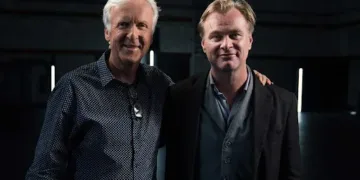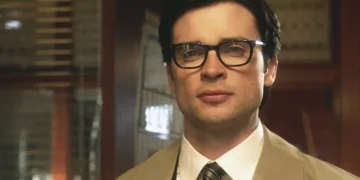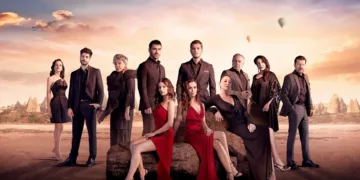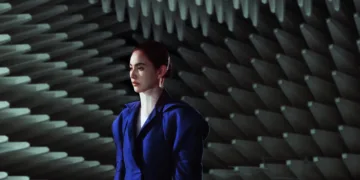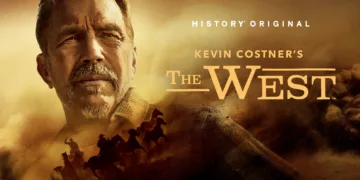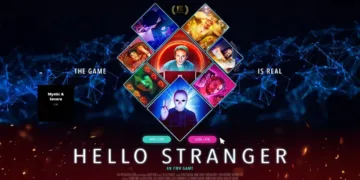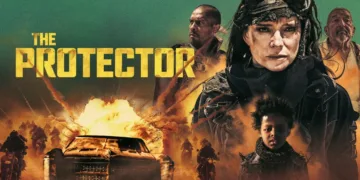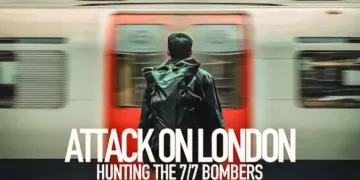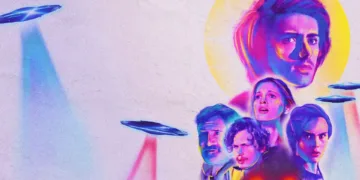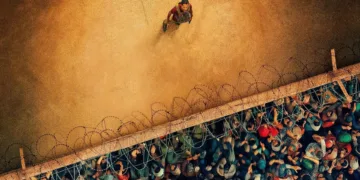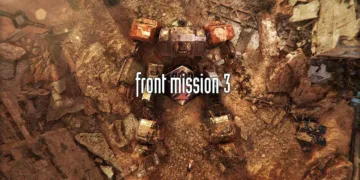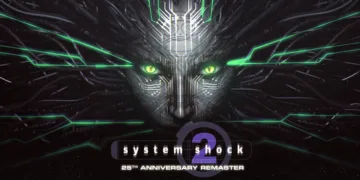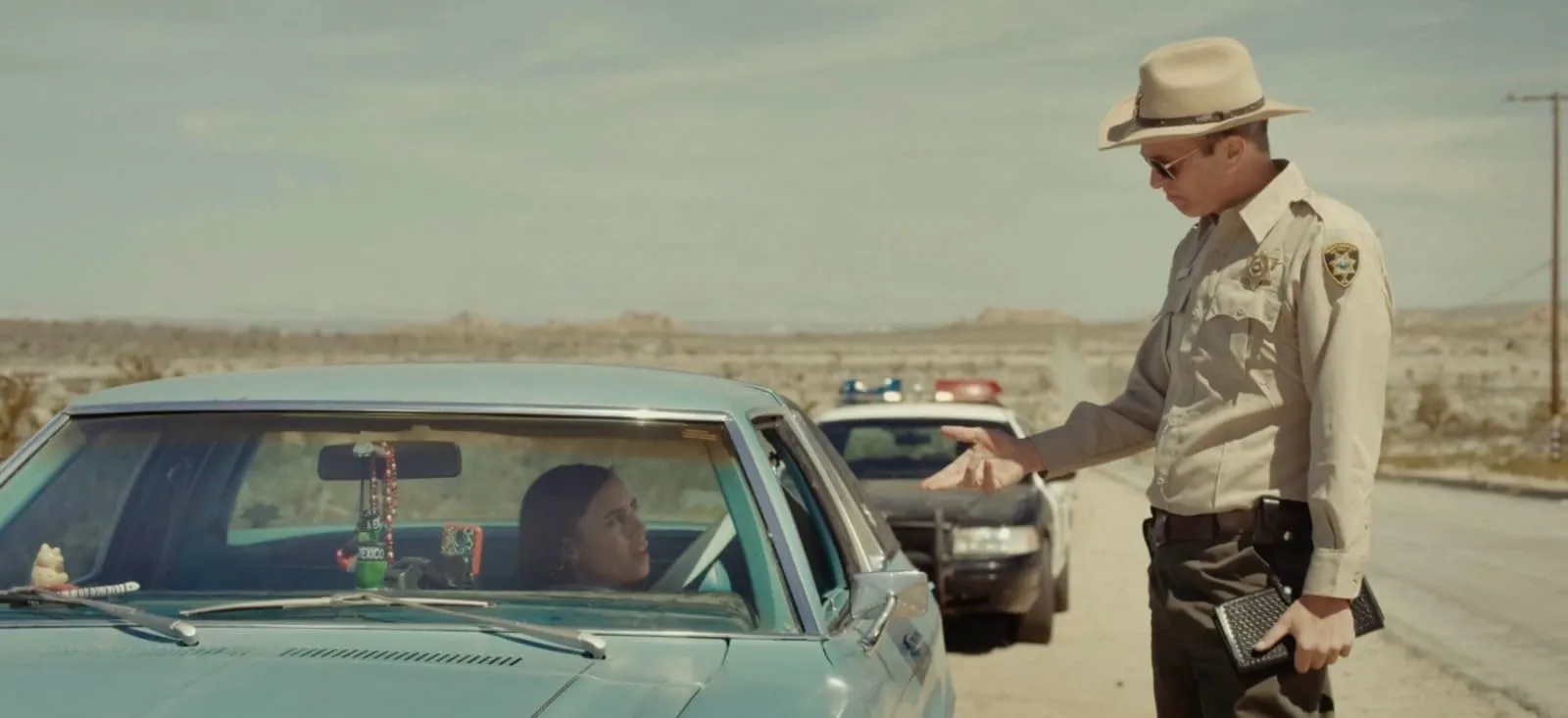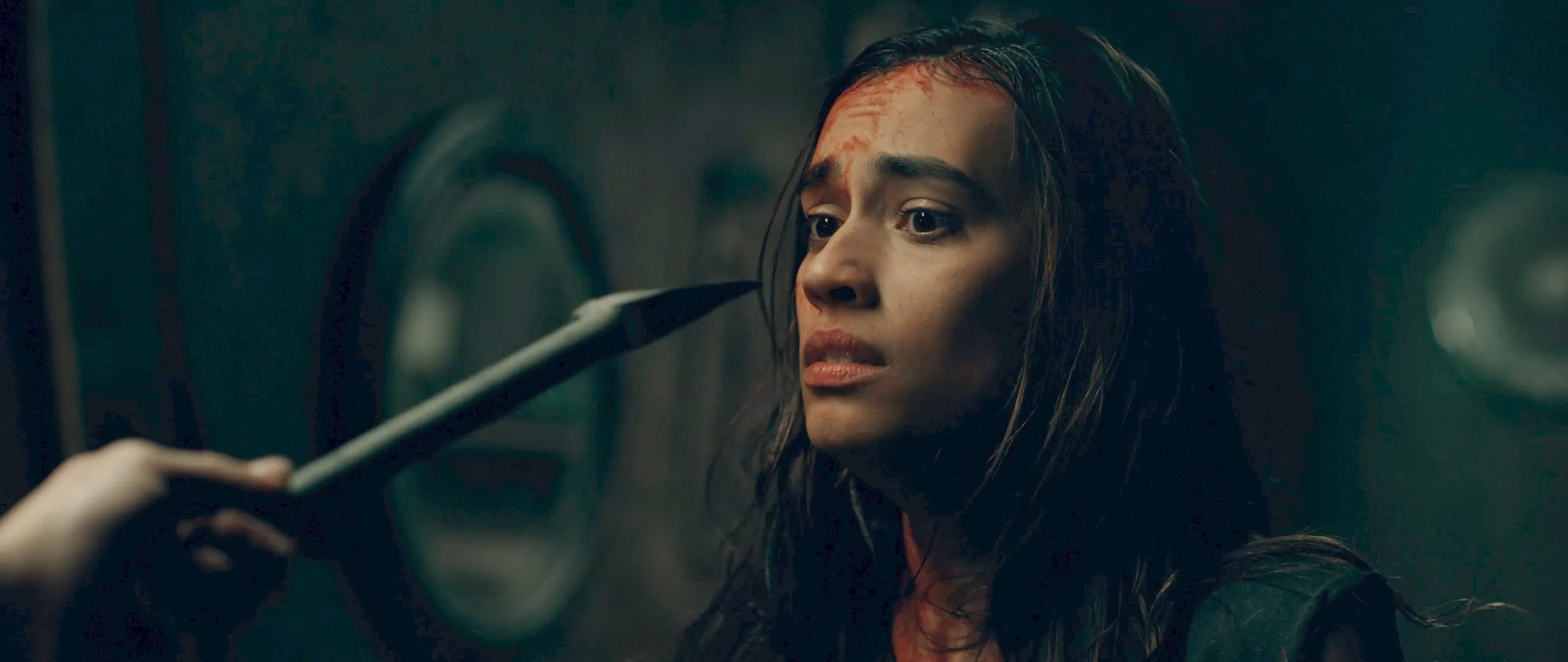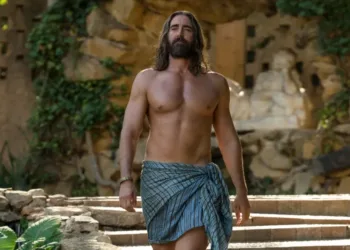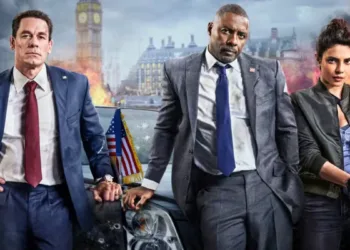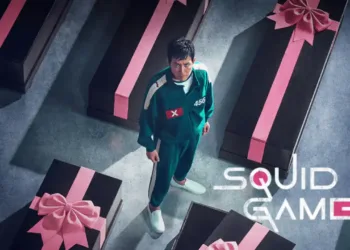In Blood Star, we meet Bobbie, a young lady whose daring journey through the New Mexico desert is both a desire for freedom and an escape from her past. Britni Camacho portrays Bobbie as a multifaceted character—a petty thief pondering a return to an abusive partner.
This internal conflict and her external problems create a captivating narrative that combines personal crises and societal commentary. As she drives her vintage Ford Mustang, the open road becomes a metaphor for her turbulent mental condition, reflecting larger themes of autonomy and vulnerability.
Bobbie’s interactions with Sheriff Bilstein, played by John Schwab, spark the film’s rising tension. Their interactions begin with a routine traffic stop and gradually escalate into a terrifying game of cat and mouse. Bilstein’s predatory behavior reveals a disturbing undercurrent of misogyny, turning what should have been a normal journey into a desperate struggle for survival.
Key moments, such as the sheriff’s promise to reduce her fine in exchange for cash and the following confiscation of her phone, are brilliantly designed to heighten the film’s dread. These critical interactions not only move the narrative ahead but also require Bobbie to confront her resilience in the face of a relentless corrupt authority figure. In this sense, Blood Star effectively combines character development with a thematic study of power dynamics, making Bobbie’s journey relevant on both a personal and societal scale.
Unpacking the Characters: Power, Vulnerability, and Survival in Blood Star
In Blood Star, Bobbie emerges as a captivating protagonist whose journey is marked by a complicated interplay of motivations and obstacles. Bobbie, a young woman on the verge of returning to an abusive relationship, is torn between the appeal of the past and the longing for autonomy.
Her character development is one of progressive empowerment, as she is forced to confront her inner problems and the exterior challenges Sheriff Bilstein offers. The film skillfully emphasizes her weaknesses, with her poor relationship with her boyfriend and strained communication with her sister serving as heartbreaking reminders of the cycle of abuse and the societal constraints that accompany it.
As Bobbie travels across the harsh landscape of New Mexico, her transformation from passive victim to resourceful survivor becomes a prominent motif, reflecting bigger cultural concerns about female agency and safety in a patriarchal world.
Sheriff Bilstein, portrayed with terrifying malice by John Schwab, starkly contrasts Bobbie. As a small-town cop, he personifies the archetype of the corrupt authority figure, wielding power with a cruel edge. His motivations are strongly entrenched in a mistaken sense of control since he enjoys the chase rather than pursuing financial gain.
This relationship not only heightens the tension but also acts as a critique of institutional misogyny and how societal mechanisms can exploit the defenseless. Bilstein’s character illustrates a troubling reality: people supposed to protect can become the source of harm. His interactions with Bobbie are fraught with psychological deception, highlighting the awful reality of facing a predator posing as a protector.
In Blood Star, the secondary characters also contribute substantially to the narrative. Amy, a waitress who briefly accompanies Bobbie on her journey, symbolizes a point of connection and shared experience. Their link over past pain provides Bobbie camaraderie in an otherwise solitary position.
Other characters, such as the drug-using youngster at the gas station, provide depth to the film’s portrayal of desperation and societal disintegration. Whether fleeting or more detailed, each character contributes to Bobbie’s story by stressing the complexity of survival in a dangerous world. Blood Star uses these relationships to tell a thrilling story of tension and suspense while delving into the emotional landscapes of trauma and resilience.
Themes and Motifs: A Deep Dive into Blood Star
In Blood Star, the themes of narrative and character are woven deeply into the fabric of the narrative, revealing themselves via the characters’ experiences and interactions. Bobbie’s journey powerfully depicts the societal influences that perpetuate cycles of abuse and fear.
The film brilliantly depicts power dynamics, notably her interactions with Sheriff Bilstein, whose predatory behavior represents a larger cultural critique of how women are frequently made impotent in the face of authority. Each uncomfortable meeting emphasizes Bobbie’s vulnerability, making her struggle not only personal but also representative of a systemic issue that resonates with modern audiences.
The predator-prey relationship heightens the film’s tension by highlighting survival instincts in a world where trust is risky. Bobbie’s transformation from a terrified young woman to a tenacious survivor is captivating. She is constantly facing challenges from Bilstein and the harsh landscape, requiring her to rely on her wits and resilience. This struggle for survival draws on a primal narrative that has echoed throughout cinema history, reminding us of our natural impulse to fight against injustice.
Blood Star also pays homage to classic horror cliches, with influences from films like Duel and The Hitcher. These influences may be seen in the film’s cat-and-mouse structure and study of the isolated, risky road journey, both of which are genre staples. By combining traditional components with current themes, Jacomelli creates a film that is both familiar and new, asking viewers to reflect on the societal worries that lurk beneath the surface. This interplay of homage and creativity places Blood Star in the tradition of survival thrillers while defying their conventions, making it a thought-provoking entry into the genre.
Cinematography and Direction: Crafting Tension in Blood Star
Lawrence Jacomelli’s directorial technique in Blood Star demonstrates a deep mastery of the thriller genre, combining conventional storytelling with a modern sensibility. His method is distinguished by a deliberate pacing that progressively heightens tension, allowing viewers to fully absorb the somber mood of the New Mexico desert.
Jacomelli’s meticulous attention to character dynamics and psychological subtlety enhances the narrative, creating a real sense of dread that resonates throughout the film. This is most evident in his ability to alternate between moments of quiet meditation and spurts of explosive action, a style that keeps audiences on edge.
The film’s visual approaches are critical to its narration, making the environment a character in and of itself. The immense, parched stretches of the New Mexico desert serve not only as a background but also as a representation of Bobbie’s loneliness and desperation. Cinematographer Pascal Combes-Knoke captures the stark grandeur of the landscape, which contrasts with the narrative’s somber undertones. Sweeping vistas of deserted roadways give a sense of freedom and danger, yet tighter close-ups highlight the characters’ emotional states, especially during the confrontation.
Several memorable film moments stand out, including the terrifying sequence in which Sheriff Bilstein meets Bobbie at the gas station. This interaction’s tight framing and low angles enhance the power discrepancy, making Bilstein appear even more intimidating. A dramatic scenario involving Bobbie’s Mustang rushing down the highway with the sun setting in the background captures her need for escape and the approaching threat behind her.
These visual components improve the film’s aesthetic and deepen its conceptual resonance, allowing viewers to engage with it on several levels. Blood Star distinguishes itself as a notable investigation of fear and survival in independent and mainstream cinematic environments, thanks to its unique blend of artistic approaches and narrative depth.
Pacing and Structure: The Rhythm of Suspense in Blood Star
Blood Star skillfully maintains suspense with a meticulously planned pacing approach that keeps viewers on the edge. Jacomelli immediately sets a rhythm, alternating between moments of peaceful meditation and unexpected, heart-pounding conflicts.
This ebb and flow heightens the tension and allows the spectator to empathize with Bobbie’s situation. The film feeds on its ability to generate a sense of inevitability, with each encounter with Sheriff Bilstein feeling fraught with peril, heightening anticipation for what’s next. This strategy is reminiscent of classic thrillers, particularly the slow-building dread prevalent in Hitchcock’s films, when the banal may quickly become threatening.
Blood Star is mostly consistent in terms of narrative structure, seamlessly incorporating Bobbie’s past into the impending events. The linear timeline used in the film enhances clarity, allowing viewers to understand the stakes as Bobbie deals with her circumstances.
The flashbacks and phone talks with her sister deepen our comprehension of her character while emphasizing the severity of her current situation. This direct method works well in a genre where complexity may sometimes dilute tension, keeping the focus squarely on Bobbie’s survival against the oppressive forces that surround her.
However, there are moments when the tempo falters, especially in the film’s midsection. While including secondary characters, such as Amy, is enriching, it does occasionally cause lulls in momentum. These passages, while character-driven, often feel like they slow down the narrative when the stakes are highest. Tighter editing in these spots would help the film maintain its tension as it builds to the finale. This minor contradiction serves as a reminder that, while Blood Star shines in many areas, it is still forging its route within the larger terrain of suspenseful film.
Social Commentary: Unpacking the Themes in Blood Star
Blood Star is a moving investigation of domestic abuse, presenting it as a prevalent phenomenon that resonates strongly in contemporary culture. Bobbie’s character provides a captivating lens through which the film investigates the psychological and emotional costs of violent relationships.
Her mental battle over returning to her partner exemplifies the complexities that many people face while trapped in cycles of violence. The film does not shy away from conveying the fear and manipulation that frequently accompany such circumstances, creating a visceral and unpleasant picture that encourages viewers to reflect on the larger consequences of domestic abuse. This thematic focus is consistent with a growing trend in cinema that tries to highlight a taboo subject, making Blood Star an important contribution to the discourse on women’s experiences.
The portrayal of authority officials, particularly Sheriff Bilstein, enhances the film’s critical stance on law enforcement. Instead of representing protection and justice, Bilstein is portrayed as a corrupt and predatory man who uses his position to intimidate and control. This inversion of expectations reflects the justice system’s shortcomings, particularly in cases involving domestic abuse.
Bilstein’s actions raise troubling questions about who can be trusted, confirming the notion that people sworn to protect may cause harm instead. This representation invites audiences to reassess their ideas about authority, especially in a cultural time when questions about police reform and accountability are at the forefront.
In reflecting contemporary societal challenges, Blood Star resonates with audiences struggling with the reality of power dynamics, gender-based violence, and the complexities of agency. The film draws on the public consciousness around the #MeToo movement and ongoing discussions about consent and vulnerability.
By setting Bobbie’s struggle against her abuser and a corrupt sheriff inside a thriller framework, the film not only entertains but also prompts critical reflection on the societal institutions that allow such dynamics to perpetuate. This topical relevance highlights Blood Star as an important cultural asset, enabling viewers to engage with pressing concerns while immersed in the tension and excitement of a well-crafted narrative.
Conclusion: The Resonance of Blood Star
Blood Star leaves a lasting impression on viewers, not only as a gripping thriller but also as a thought-provoking investigation of complicated themes such as domestic abuse and the interplay of power. One of the film’s greatest virtues is its ability to elicit a genuine emotional response from audiences dragged into Bobbie’s tragic journey. The tension is real, and each twist and turn captivates viewers, reflecting the film’s ability to maintain suspense while challenging societal standards.
Among its numerous strengths, the film’s cinematography and directing stand out, creating a harsh yet stunning visual landscape that enhances the narrative’s emotional impact. Jacomelli’s expert pacing creates a sense of dread that reflects Bobbie’s psychological difficulties, making her situation all the more real. However, while the film succeeds in character development and thematic depth, the midsection suffers from pacing problems. These lulls, while character-driven, can disturb the overall tension and pace, reminding us that even the best-crafted films have flaws.
Blood Star stands out in the thriller genre as a whole. It incorporates classic aspects, such as the cat-and-mouse chase and the dogged pursuit of a protagonist. It also challenges expectations with its complex representation of authority and gender dynamics.
This duality distinguishes the film as a key contribution to contemporary independent cinema, reflecting the growing tendency of directors to adopt genre conventions to address pressing societal issues. As we navigate a cultural landscape rife with discussions about power, agency, and the complexities of human relationships, Blood Star stands out as both a riveting thriller and an important cultural relic.
The Review
Blood Star
Blood Star captivates with its captivating narrative and profound themes, expertly blending a horrific depiction of domestic abuse with a tight thriller structure. Jacomelli's directing and arresting photography add to the emotional depth, and the film's criticism of authority and societal concerns resonate strongly with modern audiences. Despite minor pacing flaws, its benefits greatly surpass its weaknesses, making it an important addition to the genre.
PROS
- Gripping narrative that maintains suspense.
- Strong character development, particularly of Bobbie.
- Thoughtful exploration of themes like domestic violence and authority.
- Striking cinematography that enhances the emotional impact.
- Engaging pacing, especially in the buildup of tension.
CONS
- Occasional pacing issues in the midsection.
- Some supporting characters could be better developed.
- Predictable elements in certain thriller tropes.














